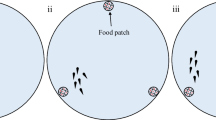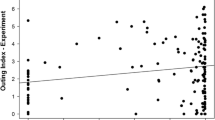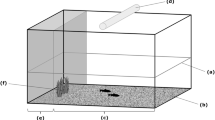Abstract
Groups of animals are often heterogeneously structured and may be composed of selfish individuals responding to different internal stimuli. Group-level behaviour can be determined by the slight differences in simple behavioural movement parameters structuring local interactions between conspecifics. To accurately understand individual behaviour within groups and how it affects whole-group behaviour, we need to measure the responses of individuals in groups to changes in internal state and examine the outcome of these responses within the social context. Therefore, we quantified the influence of nutritional state on the individual and group movement parameters of free swimming shoals of eight rainbow fish, Melanotaenia duboulayi. Individual fish were experimentally manipulated to be in one of two nutritional states, hungry or satiated, and were assayed in three group compositions: all-hungry (8:0 hungry/satiated), mixed (4:4) or all-satiated (0:8). We showed that the internal nutritional state of individual fish affected basic behaviours relating to spatial positioning. The interaction between pairs of fish was dependent on the nutritional state of both fish, and there was an additive effect of individual behaviour on group behaviour, which meant that group behaviour reflected the motivations of its individual members in such a way that allowed individuals to fulfil their own behavioural needs whilst still attaining the benefits of grouping.



Similar content being viewed by others
References
Barber I, Downey LC, Braithwaite VA (1998) Parasitism, oddity and the mechanism of shoal choice. J Fish Biol 53:1365–1368
Bazazi S, Romanczuk P, Thomas S, Schimansky-Geier L, Hale JJ, Miller GA, Sword GA, Simpson SJ, Couzin ID (2010) Nutritional state and collective motion: from individuals to mass migration. Proc R Soc Lond B 278:356–363
Beekman M, Fathke RL, Seeley TD (2006) How does an informed minority of scouts guide a honeybee swarm as it flies to its new home? Anim Behav 71:161–171
Berdahl A, Torney CJ, Ioannou CC, Faria JJ, Couzin ID (2013) Emergent sensing of complex environments by mobile animal groups. Science 339:574–576
Biro PA, Stamps JA (2010) Do consistent individual differences in metabolic rate promote consistent individual differences in behaviour? Trends Ecol Evol 25:653–659
Branson K, Robie AA, Bender J, Perona P, Dickinson MH (2009) High-throughput ethomics in large groups of Drosophila. Nat Methods 6:451–457
Brown C (2000) The behavioural ecology of predator avoidance in rainbowfish (Melanotaenia spp.). Dissertation, University of Queensland
Brown C, Irving E (2013) Individual personality traits influence group exploration in a feral guppy population. Behav Ecol 25:95–101
Brown C, Laland KN (2003) Social learning in fishes: a review. Fish Fish 4:280–288
Bumann D, Krause J, Rubenstein D (1997) Mortality risk of spatial positions in animal groups: the danger of being in the front. Behaviour 134:1063–1076
Camazine S, Deneubourg J, Franks N, Sneyd J, Theraulaz G (2001) Self-organization in biological systems. Princeton University Press, Princeton
Conradt L (2012) Models in animal collective decision-making: information uncertainty and conflicting preferences. Interface Focus 2:226–240
Conradt L, Roper TJ (2005) Consensus decision making in animals. Trends Ecol Evol 20:449–456
Conradt L, Roper TJ (2009) Conflicts of interest and the evolution of decision sharing. Philos Trans R Soc B 364:807–819
Conradt L, Krause J, Couzin ID, Roper TJ (2009) “Leading according to need” in self‐organizing groups. Am Nat 173:304–312
Cote J, Clobert J, Brodin T, Fogarty S, Sih A (2010a) Personality-dependent dispersal: characterization, ontogeny and consequences for spatially structured populations. Philos Trans R Soc B 365:4065–4076
Cote J, Fogarty S, Weinersmith K, Brodin T, Sih A (2010b) Personality traits and dispersal tendency in the invasive mosquitofish (Gambusia affinis). Proc R Soc Lond B 277:1571–1579
Couzin ID, Krause J (2003) Self-organization and collective behavior in vertebrates. Adv Study Behav 32:1–75
Couzin ID, Krause J, James R, Ruxton GD, Franks NR (2002) Collective memory and spatial sorting in animal groups. J Theor Biol 218:1–11
Couzin ID, Krause J, Franks NR, Levin SA (2005) Effective leadership and decision-making in animal groups on the move. Nature 433:513–516
Couzin ID, Ioannou CC, Demirel G, Gross T, Torney CJ, Hartnett A, Conradt L, Levin SA, Leonard NE (2011) Uninformed individuals promote democratic consensus in animal groups. Science 334:1578–1580
Croft DP, Krause J, James R (2004) Social networks in the guppy (Poecilia reticulata). Proc R Soc Lond B 271:S516–S519
Croft DP, James R, Ward AJW, Botham MS, Mawdsley D, Krause J (2005) Assortive interactions and social networks in fish. Oecologia 143:211–219
Derby CD, Sorensen PW (2008) Neural processing, perception, and behavioral responses to natural chemical stimuli by fish and crustaceans. J Chem Ecol 34:898–914
Dosdat A, Servais F, Metailler R, Huelvan C, Desbruyeres E (1996) Comparison of nitrogenous losses in five teleost fish species. Aquaculture 141:107–127
Frommen JG, Luz C, Bakker TCM (2007) Nutritional state influences shoaling preference for familiars. Zoology 110:369–376
Giaquinto PC, Hara TJ (2008) Discrimination of bile acids by the rainbow trout olfactory system: evidence as potential pheromone. Biol Res 41:33–42
Giraldeau LA, Caraco T (2000) Social foraging theory. Princeton University Press, Princeton
Griffiths SW, Magurran AE (1997) Familiarity in schooling fish: how long does it take to acquire? Anim Behav 53:945–949
Gueron S, Levin SA, Rubenstein DI (1996) The dynamics of herds: from individuals to aggregations. J Theor Biol 182:85–98
Hansen MJ, Schaerf TM, Ward AJW (2015) The effect of hunger on the exploratory behaviour of shoals of mosquitofish Gambusia holbrooki. Behaviour (published online). doi:10.1163/15685396-00003298
Hastie R, Kameda T (2005) The robust beauty of majority rules in group decisions. Psychol Rev 112:494–508
Hensor EMA, Godin J-GJ, Hoare DJ, Krause J (2003) Effects of nutritional state on the shoaling tendency of banded killifish, Fundulus diaphanus, in the field. Anim Behav 65:663–669
Herbert-Read JE, Perna A, Mann RP, Schaerf TM, Sumpter DJT, Ward AJW (2011) Inferring the rules of interaction of shoaling fish. Proc Natl Acad Sci USA 108:18726–18731
Herbert-Read JE, Krause S, Morrell LJ, Schaerf TM, Krause J, Ward AJW (2013) The role of individuality in collective group movement. Proc R Soc B 280:20122564
Hoare DJ, Couzin ID, Godin J-GJ, Krause J (2004) Context-dependent group size choice in fish. Anim Behav 67:155–164
Holm S (1979) A simplee sequentially rejective multiple test procedure. Scand J Stat 6:65–70
Huth A, Wissel C (1992) The simulation of the movement of fish schools. J Theor Biol 156:365–385
Janson S, Middendorf M, Beekman M (2005) Honeybee swarms: how do scouts guide a swarm of uninformed bees? Anim Behav 70:349–358
Johnstone RA, Manica A (2011) Evolution of personality differences in leadership. Proc Natl Acad Sci U S A 108:8373–8378
Jolles JW, King AJ, Manica A, Thornton A (2013) Heterogeneous structure in mixed-species corvid flocks in flight. Anim Behav 85:743–750
Jordan LA, Avolio C, Herbert-Read JE, Krause J, Rubenstein DI, Ward AJW (2010) Group structure in a restricted entry system is mediated by both resident and joiner preferences. Behav Ecol Sociobiol 64:1099–1106
King AJ, Cowlishaw G (2007) When to use social information: the advantage of large group size in individual decision making. Biol Lett 3:137–139
King AJ, Douglas CMS, Huchard E, Isaac NJB, Cowlishaw G (2008) Dominance and affiliation mediate despotism in a social primate. Curr Biol 18:1833–1838
Krause J (1993a) The effect of ‘Schreckstoff’ on the shoaling behaviour of the minnow: a test of Hamilton’s selfish herd theory. Anim Behav 45:1019–1024
Krause J (1993b) The influence of hunger on shoal size choice by three-spined sticklebacks, Gasterosteus aculeatus. J Fish Biol 43:775–780
Krause J (1993c) The relationship between foraging and shoal position in a mixed shoal of roach (Rutilus rutilus) and chub (Leuciscus cephalus): a field study. Oecologia 93:356–359
Krause J (1994) Differential fitness returns in relation to spatial position in groups. Biol Rev 69:187–206
Krause J, Godin J-GJ (1996) Influence of parasitism on shoal choice in the banded killifish (Fundulus diaphanus, Teleostei, Cyprinodontidae). Ethology 102:40–49
Krause J, Ruxton G (2002) Living in groups. Oxford University Press, New York
Krause J, Bumann D, Todt D (1992) Relationship between the position preference and nutritional state of individuals in schools of juvenile roach (Rutilus rutilus). Behav Ecol Sociobiol 30:177–180
Krause J, Hartmann N, Pritchard VL (1999) The influence of nutritional state on shoal choice in zebrafish, Danio rerio. Anim Behav 57:771–775
Krause J, Butlin RK, Peuhkuri N, Pritchard VL (2000a) The social organisation of fish shoals: a test of the predictive power of laboratory experiments for the field. Biol Rev Camb Philos 75:477–501
Krause J, Hoare DJ, Croft D, Lawrence J, Ward A, Ruxton GD, Godin J-GJ, James R (2000b) Fish shoal composition: mechanisms and constraints. Proc R Soc Lond B 267:2011–2017
Kydd E, Brown C (2009) Loss of shoaling preference for familiar individuals in captive‐reared crimson spotted rainbowfish Melanotaenia duboulayi. J Fish Biol 74:2187–2195
McRobert SP, Bradner J (1998) The influence of body colouration on shoaling preferences in fish. Anim Behav 56:611–615
Metcalfe NB, Thomson BC (1995) Fish recognize and prefer to shoal with poor competitors. Proc R Soc Lond B 259:207–210
Morgan MJ (1988) The influence of hunger, shoal size and predator presence on foraging in bluntnose minnows. Anim Behav 36:1317–1322
Morrell LJ, Hunt KL, Croft DP, Krause J (2007) Diet, familiarity and shoaling decisions in guppies. Anim Behav 74:311–319
Nagy M, Akos Z, Biro D, Vicsek T (2010) Hierarchical group dynamics in pigeon flocks. Nature 464:890–893
Olsén KH, Grahn M, Lohm J (2003) The influence of dominance and diet on individual odours in MHC identical juvenile Arctic charr siblings. J Fish Biol 63:855–862
Piyapong C, Krause J, Chapman BB, Ramnarine IW, Louca V, Croft DP (2010) Sex matters: a social context to boldness in guppies (Poecilia reticulata). Behav Ecol 21:3–8
R Development Core Team (2014) R: a language and environment for statistical computing. R Foundation for Statistical Computing, Vienna, Austria
Rands SA, Pettifor RA, Rowcliffe JM, Cowlishaw G (2004) State-dependent foraging rules for social animals in selfish herds. Proc R Soc Lond B 271:2613–2620
Ranta E, Lindström K (1990) Assortative schooling in three-spined sticklebacks. Ann Zool Fenn 27:67–95
Reebs SG (2000) Can a minority of informed leaders determine the foraging movements of a fish shoal? Anim Behav 59:403–409
Reebs SG, Saulnier N (1997) The effect of hunger on shoal choice in golden shiners (Pisces: Cyprinidae, Notemigonus crysoleucas). Ethology 103:642–652
Robinson C, Pitcher T (1989a) Hunger motivation as a promoter of different behaviours within a shoal of herring: selection for homogeneity in fish shoal? J Fish Biol 35:459–460
Robinson C, Pitcher T (1989b) The influence of hunger and ration level on shoal density, polarization and swimming speed of herring, Clupea harengus L. J Fish Biol 34:631–633
Robson SK, Traniello JF (2002) Transient division of labor and behavioral specialization in the ant Formica schaufussi. Naturwissenschaften 89:128–131
Rodgers GM, Kelley JL, Morrell LJ (2010) Colour change and assortment in the western rainbowfish. Anim Behav 79:1025–1030
Romey WL (1995) Position preferences within groups: do whirligigs select positions which balance feeding opportunities with predator avoidance? Behav Ecol Sociobiol 37:195–200
Romey WL (1996) Individual differences make a difference in the trajectories of simulated schools of fish. Ecol Model 92:65–77
Schultz KM, Passino KM, Seeley TD (2008) The mechanism of flight guidance in honeybee swarms: subtle guides or streaker bees? J Exp Biol 211:3287–3295
Sih A, Watters JV (2005) The mix matters: behavioural types and group dynamics in water striders. Behaviour 142:1417–1431
Stienessen SC, Parrish JK (2013) The effect of disparate information on individual fish movements and emergent group behavior. Behav Ecol 24:1150–1160
Strandburg-Peshkin A, Farine DR, Couzin ID, Crofoot MC (2015) Shared decision-making drives collective movement in wild baboons. Science 348:1358–1361
Stroeymeyt N, Franks NR, Giurfa M (2011) Knowledgeable individuals lead collective decisions in ants. J Exp Biol 214:3046–3054
Sueur C, Deneubourg J-L, Petit O, Couzin ID (2010) Differences in nutrient requirements imply a non-linear emergence of leaders in animal groups. PLoS Comput Biol 6, e1000917
Sumpter DJ (2010) Collective animal behavior. Princeton University Press, Princeton
Sumpter DJT, Krause J, James R, Couzin ID, Ward AJW (2008) Consensus decision making by fish. Curr Biol 18:1773–1777
Ward AJW (2012) Social facilitation of exploration in mosquitofish (Gambusia holbrooki). Behav Ecol Sociobiol 66:223–230
Ward AJW, Hart PJB, Krause J (2004) The effects of habitat-and diet-based cues on association preferences in three-spined sticklebacks. Behav Ecol 15:925
Ward AJW, Webster MM, Hart PJB (2006) Intraspecific food competition in fishes. Fish Fish 7:231–261
Ward AJW, Herbert-Read JE, Simpson SJ (2011) Diets and decisions: the potential use of food protein cues in dietary, sexual and social decisions by mosquitofish. Anim Behav 82:783–790
Webster MM, Adams EL, Laland KN (2008) Diet-specific chemical cues influence association preferences and prey patch use in a shoaling fish. Anim Behav 76:17–23
Acknowledgments
The authors acknowledge that this work was funded by the Australian Research Council via DP130101670.
Ethical approval
All applicable international, national and/or institutional guidelines for the care and use of animals were followed. All procedures performed were in accordance with the ethical standards of the University of Sydney.
Author information
Authors and Affiliations
Corresponding author
Additional information
Communicated by J. Frommen
Electronic supplementary material
Below is the link to the electronic supplementary material.
ESM 1
(DOC 1.45 mb)
Rights and permissions
About this article
Cite this article
Hansen, M.J., Schaerf, T.M. & Ward, A.J.W. The influence of nutritional state on individual and group movement behaviour in shoals of crimson-spotted rainbowfish (Melanotaenia duboulayi). Behav Ecol Sociobiol 69, 1713–1722 (2015). https://doi.org/10.1007/s00265-015-1983-0
Received:
Revised:
Accepted:
Published:
Issue Date:
DOI: https://doi.org/10.1007/s00265-015-1983-0




